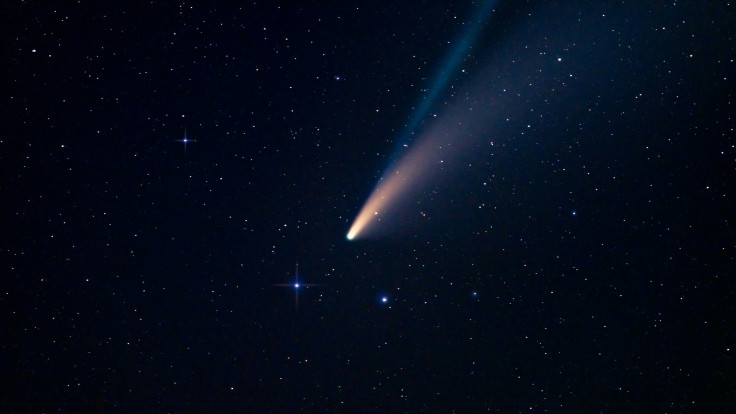Avi Loeb Warns 3I/ATLAS Could Deliver 'Unwanted Gifts to Earth' Soon
Is 3I/ATLAS an alien ship? New images show 'thrusters', as Harvard's Avi Loeb warns of 'unwanted gifts' by 19 December.

It came from deep space, and the questions surrounding it are only growing. The mysterious, ~20-kilometre (12-mile) wide object 3I/ATLAS is once again stoking speculation that it may not be a natural comet at all.
This latest furore comes after fresh images captured this week revealed 'a complex jet structure',. One prominent astrophysicist speculates this structure could be a form of technological propulsion.
This is just the latest anomaly in a months-long saga that has pitted scientific convention against the tantalising possibility that humanity is being visited by an extraterrestrial probe.

'Thrusters Used for Navigation': The New Jet Images of 3I/ATLAS
The new images, captured on 8 November 2025, by astronomers Michael Jäger, G. Rhemann, and E. Prosperi, are the most detailed yet, showing at least seven distinct jets firing from the object. Most alarmingly, some of these are 'anti-tails.'
This means they are ejecting material towards the sun, the opposite of a typical comet tail which is always pushed away by solar wind.
Dr Avi Loeb, the Harvard astrophysicist closely tracking the object, immediately noted the implications in a piece published on Medium on Saturday, 8 November. He speculated that the jets could be 'coming from a set of thrusters used for navigation of a spacecraft.'
However, Loeb was quick to concede a natural (though unusual) explanation. He wrote that the jets could also be 'associated with pockets of ice on the surface of a natural cometary nucleus.'
The good news is, we may not have to guess for long. 'It would be easy to test whether 3I/ATLAS is natural or technological by measuring the outflow velocity, mass flux and composition of its jets during the coming month,' Loeb wrote in a follow-up piece on 9 November. The object makes its closest approach to Earth on 19 December.
With this in mind, Loeb added an ominous note: 'Let us hope 3I/ATLAS will not deliver any unwanted gifts to Earth during the holiday season.'

A Second Object: C/2025 V1 and the 3I/ATLAS Fleet Theory
As if one mysterious object were not enough, the discovery of a second 'nearly interstellar' object, officially designated C/2025 V1, has fuelled frenzied online speculation. This new object was discovered on 2 November 2025, by astronomer Gennady Borisov—the same man who discovered the second interstellar object, 2I/Borisov, in 2019.
Theories are now circulating that the objects could be related, perhaps a probe and a mothership, or a coordinated 'flotilla'.
Dr Loeb, however, appears sceptical of this specific connection. He believes the vast distance between them makes a link highly unlikely without advanced propulsion.
'C/2025 V1 is not related to 3I/ATLAS if it did not employ non-gravitational propulsion', he explained. 'The closest separation of the two orbits is 75 million kilometers (0.5 au) and the objects were never closer than 225 million kilometers (1.5 au) from each other without propulsion.'
According to Loeb, the strange acceleration 3I/ATLAS has already shown is 'insufficient to bridge the gap' between the two objects.
A History of Anomalies: Why 3I/ATLAS Baffles Scientists
This latest debate over 'thrusters' is not happening in a vacuum. Dr Loeb has been asserting that 3I/ATLAS has exhibited anomalous behaviours ever since its discovery on 1 July 2025, by the ATLAS telescope network in Chile.
The primary red flag has been the object's 'non-gravitational acceleration', which was recorded by NASA last week. This means something other than the sun's gravity is affecting its speed. Furthermore, the object glowed 'bluer than the sun.' This is inconsistent with a simple, icy comet reflecting sunlight.
In a blog post in late October 2025, the scientist wrote that this combination of factors (which he dubbed the 'ninth anomaly') could indicate the 'technological signature of an internal engine.' While sceptics continue to point towards natural (if unusual) cometary behaviour, the list of oddities for 3I/ATLAS keeps growing.
With its closest approach just weeks away, the scientific community and the public are watching with bated breath.
The list of anomalies for 3I/ATLAS is growing. What began with unnatural acceleration and a strange blue glow has now escalated to 'a complex jet structure' firing in the wrong direction. While the official explanation remains a natural comet, the data is strange enough to make even top scientists speculate about technological engines.
With Dr Avi Loeb's ominous warning about 'unwanted gifts' and the object's closest approach to Earth on 19 December, all eyes are on this interstellar visitor. The truth is out there, and it is approaching fast.
© Copyright IBTimes 2025. All rights reserved.





















